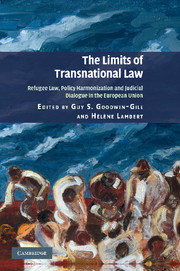 The Limits of Transnational Law
The Limits of Transnational Law Book contents
- Frontmatter
- Contents
- Notes on contributors and editors
- Acknowledgements
- Abbreviations
- 1 Transnational law, judges and refugees in the European Union
- 2 Where is the reference? On the limited role of transnational dialogue in Belgian refugee law
- 3 Transnational refugee law in the French courts: deliberate or compelled change in judicial attitudes?
- 4 The use of foreign asylum jurisprudence in the German administrative courts
- 5 The solipsistic legal monologue of Italian authorities
- 6 ‘Thou shalt not judge’ … Spanish judicial decision-making in asylum and the role of judges in interpreting the law
- 7 The British judiciary and the search for reciprocal relations with its continental partners
- 8 Speaking across borders: the limits and potential transnational dialogue on refugee law in Ireland
- 9 The absence of foreign law in Danish asylum decisions – quasi-judicial monologue with domestic policy focus?
- 10 Foreign law in Swedish judicial decision-making: playing a limited role in refugee law cases
- 11 The search for the one, true meaning …
- Bibliography
- Index
11 - The search for the one, true meaning …
Published online by Cambridge University Press: 06 July 2010
- Frontmatter
- Contents
- Notes on contributors and editors
- Acknowledgements
- Abbreviations
- 1 Transnational law, judges and refugees in the European Union
- 2 Where is the reference? On the limited role of transnational dialogue in Belgian refugee law
- 3 Transnational refugee law in the French courts: deliberate or compelled change in judicial attitudes?
- 4 The use of foreign asylum jurisprudence in the German administrative courts
- 5 The solipsistic legal monologue of Italian authorities
- 6 ‘Thou shalt not judge’ … Spanish judicial decision-making in asylum and the role of judges in interpreting the law
- 7 The British judiciary and the search for reciprocal relations with its continental partners
- 8 Speaking across borders: the limits and potential transnational dialogue on refugee law in Ireland
- 9 The absence of foreign law in Danish asylum decisions – quasi-judicial monologue with domestic policy focus?
- 10 Foreign law in Swedish judicial decision-making: playing a limited role in refugee law cases
- 11 The search for the one, true meaning …
- Bibliography
- Index
Summary
Introduction
The raison d'être of the project which lies behind this collection rests on a relatively simple thesis: that states, interpreting and applying the 1951 Convention relating to the Status of Refugees through their legislation, courts and tribunals, ought to have some regard to relevant case law from the jurisdictions of other states party to the Convention. Described in this way, the thesis leaves many questions hanging, among them, what is ‘relevant’ case law, and to what purpose and how exactly is it to be put to use.
The preceding chapters have all shown how great are the obstacles in the way of developing a coherent, harmonized, case-based approach to the Refugee Convention, notwithstanding the common history of refugee protection, recent institutional and regional initiatives, and a range of technological developments. Indeed, the opportunities for the transnational dissemination and use of comparative jurisprudence could hardly be more favourable, and increasing numbers of refugee decisions are readily available on the Web, either sponsored by the national refugee determination authority, or through the medium of third-party legal information institutes with a multi-jurisdictional content. Nevertheless, as we have seen, barriers remain. Language is still an issue and a problem that impedes access. Knowledge or sufficient knowledge of others' legal systems, hierarchy of authority, and ways of thinking, reasoning and writing are often understandably lacking, and to this may be added a measure of uncertainty regarding quite why foreign case law may be useful – not because it is binding, of course, but perhaps because it is illustrative, or confirms an actual or emerging practice among states regarding accepted interpretation, or because it is persuasively reasoned.
- Type
- Chapter
- Information
- The Limits of Transnational LawRefugee Law, Policy Harmonization and Judicial Dialogue in the European Union, pp. 204 - 241Publisher: Cambridge University PressPrint publication year: 2010
- 7
- Cited by


